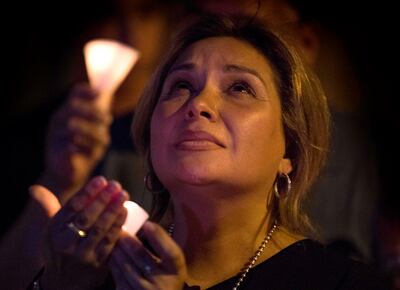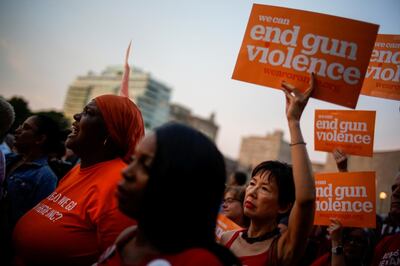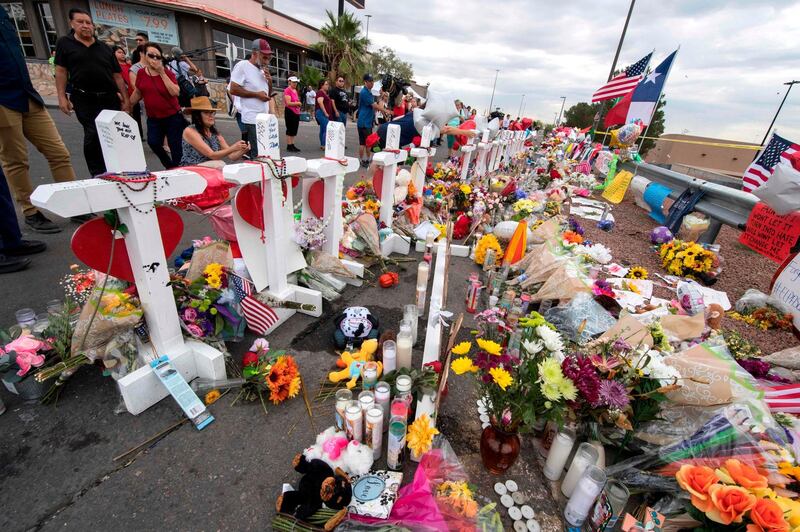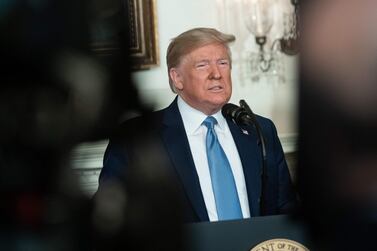The names have become bywords for pain and loss: Columbine; Newtown; Parkland.
This past weekend, El Paso and Dayton were added to the roll call of US places where relatives grieve for innocent people gunned down.
After every one of the frequent mass shootings there is shock, condemnation and sympathy. Already this year there have been 255 such attacks in the US, more than one a day, the non-profit Gun Violence Archive says.
Such is the bloodshed that at least four people must have been shot, excluding the gunman, to qualify in mass shooting statistics.
Before the attack in El Paso killed 22 people, this year's worst shooting was in Virginia Beach, where a former local government worker killed 12 on May 31.
The true toll of the US’s gun violence runs much higher. In 2019, there have been 33,237 shooting incidents, resulting in 8,796 deaths and 17,840 injuries.
That latest count, from the first 217 days of this year, easily surpasses the 6,737 American service personnel killed in Afghanistan and Iraq since 2001.
But while there is political will for overseas wars to end, there has been no unity to combat the scourge of killings on domestic soil.

Instead, a familiar pattern emerges after a mass shooting, in which the gunmen are usually white, male and angry.
There are calls for change in gun ownership laws. The suffering of families is accompanied by commentary and pictures of their loved ones. And the deadly cycle, sooner or later, is repeated.
US President Donald Trump went further than usual on Monday by acknowledging white supremacists and hatred as problems in the US. But his overall response fell short.
Like a sick patient who refuses to take their medicine, the US political class scratches their heads and quickly drop any notion of reform.
They are recalcitrant when it comes to answering critics of their approach to guns. Republican and Democratic administrations have failed to make any substantive reforms.
Mr Trump is likely to face criticism when he arrives in El Paso and Dayton on Wednesday. On Twitter on Monday, he indicated openness to stronger background checks on gun buyers if changes were paired with “desperately needed immigration reform”.
That was a calculated political move at odds with a national moment of mourning.
By the time the president made a 10-minute address from the White House he had dropped both references and gave a vague pledge of willingness to listen to “bipartisan solutions” to the gun problem.
Mr Trump’s comments indicate a disturbing reality. For all its wealth and creativity, the US is inexcusably struck dumb when it comes to gun violence.
There are many reasons why mass shooters kill people but there is one uniquely American factor that ties them together: easy and legal access to weaponry.
Much like bullets fired from an automatic rifle, arguments over gun reform are made at rapid pace. But while one weapon is ruthlessly efficient, the other always misses the target.

This time around, with the combined El Paso and Dayton death toll at 31, it is unlikely to be any different. Despite pressure on the president to do something, his suggestions were outdated.
Tying mass killings to violent videogames was an argument made after the Columbine High School massacre in 1999, in which 12 students and one teacher were killed. Those games are still sold.
His linking of the problem with hate being spread on the internet highlighted his own propensity for targeting his rivals online.
While offensive forums can ultimately be removed, the internet will not be closed down.
And Mr Trump’s assertion that “mental illness and hatred pulls the trigger, not the gun” gave succour to the National Rifle Association, whose political clout is renowned on Capitol Hill.
Representative Ted Yoho, one of the few Republicans willing to speak to the media about guns on Monday, telegraphed what was to come from Mr Trump.
“Bad people do bad things,” Mr Yoho, of Florida, told CNN, describing Democratic senator and presidential candidate Bernie Sanders’s call for Congress to be recalled from its summer break as “a joke”.
Mr Yoho proudly declares his stance on guns on his home page.
“As a proud member of the NRA, I will support legislation that protects our 2nd Amendment rights.”
There is no mood to change, despite several polls in recent years finding that between 80 and 90 per cent of Americans support background checks for gun sales.
But Mr Trump’s past words envelop him. After a white supremacist in March killed 51 men, women and children in the mass shooting in Christchurch, New Zealand, the US president denied it was a rising threat, classing it a problem among “a small number of people”.
It is also intriguing that the El Paso shooter posted an online rant blaming migrants for invading the US. Unusually, the gunman survived the incident and has yet to express any remorse.
Any parallels between his views and Mr Trump’s hardline tirades on immigration could become difficult for the president to distance himself from. This explained the president’s unprecedented condemnation on Monday of white supremacy.
In contrast, his Democratic rivals for the presidency in 2020 accuse him, through Twitter and campaign speeches, of stoking hate.
Mr Trump’s visits to Texas and Ohio may produce some calls for action but any debate will last only a few days.
It is a sad indictment of US politics that the race for the White House will last much longer and suck up more energy and money than any effort to stop its own people dying in mass shootings.







